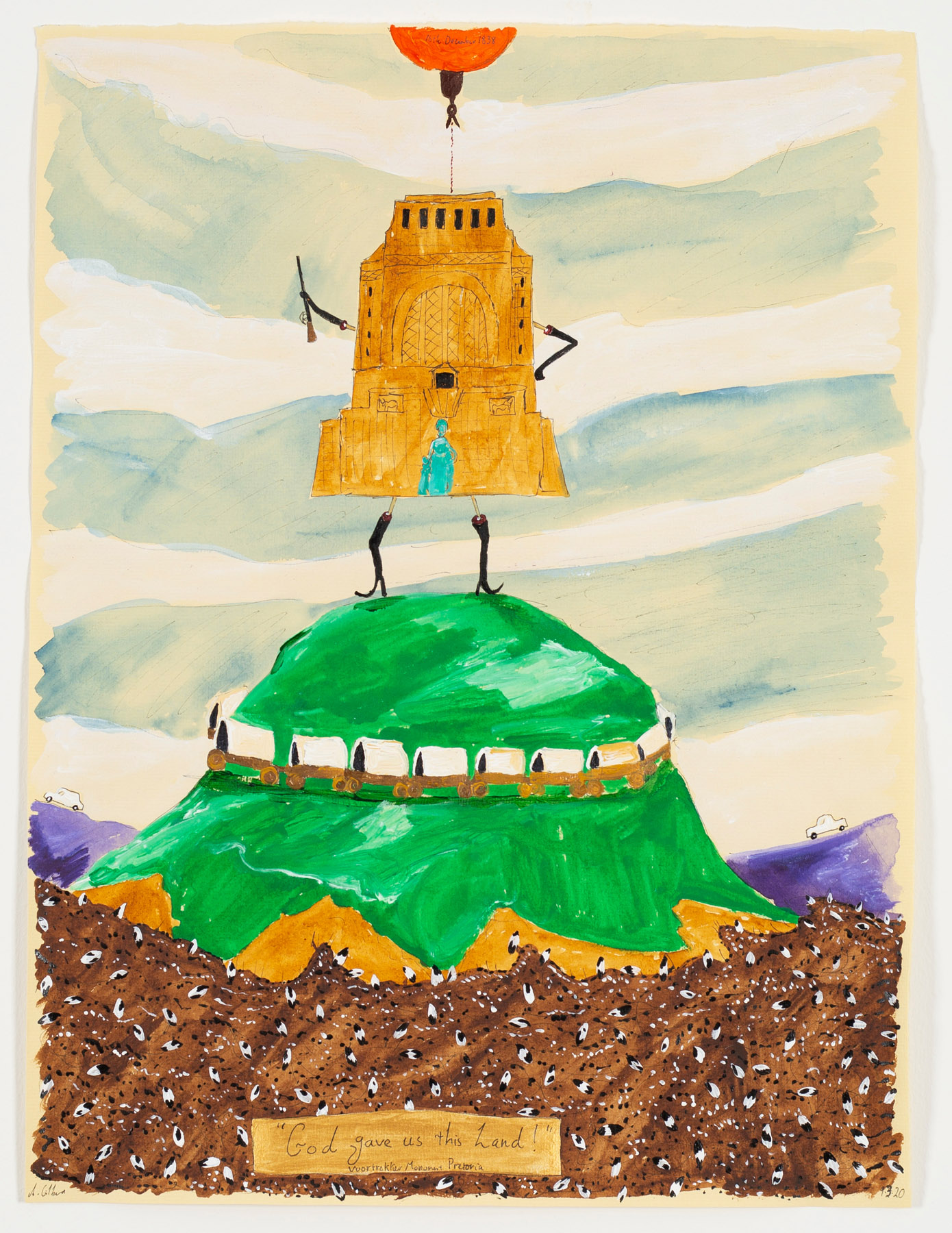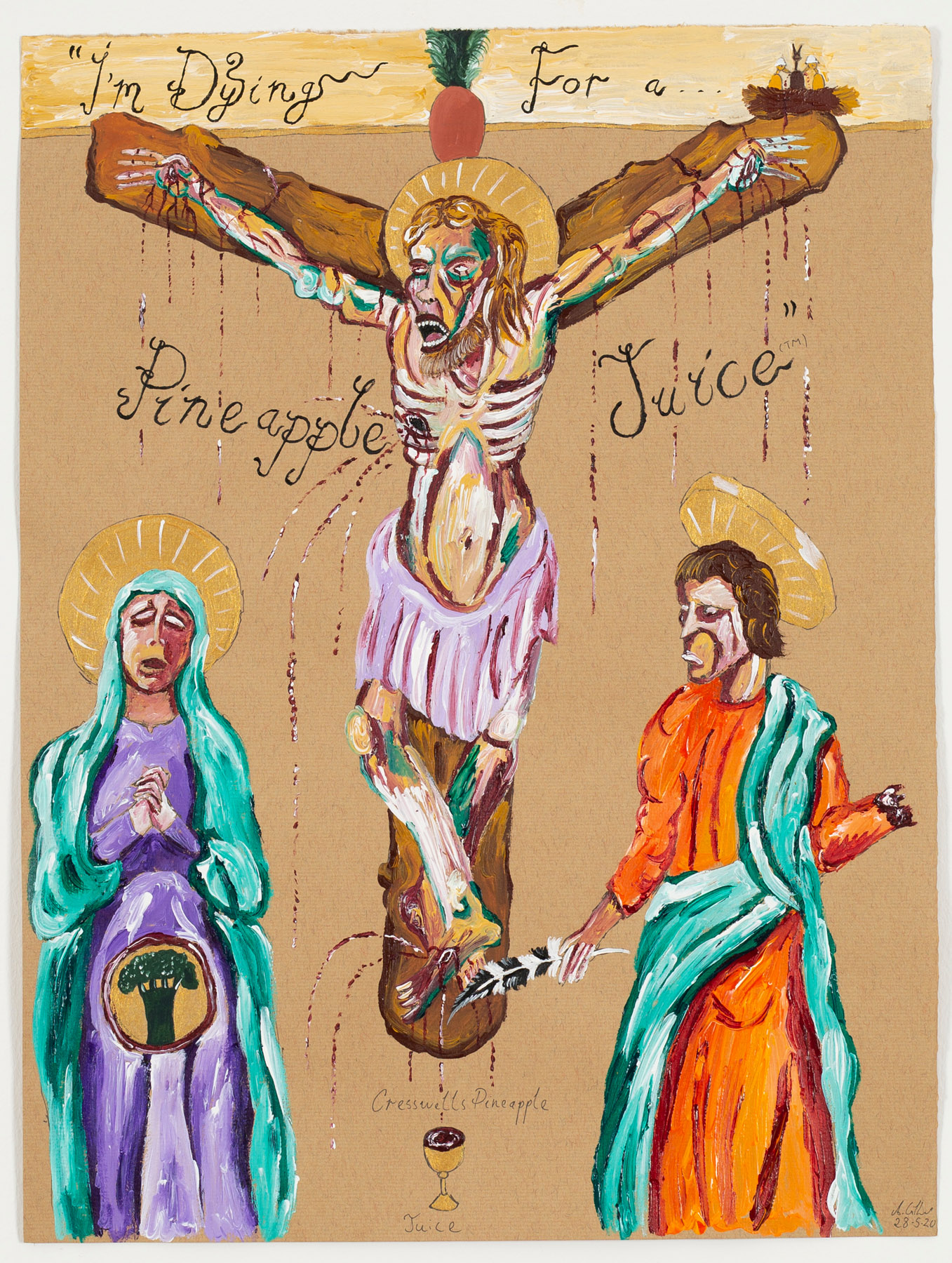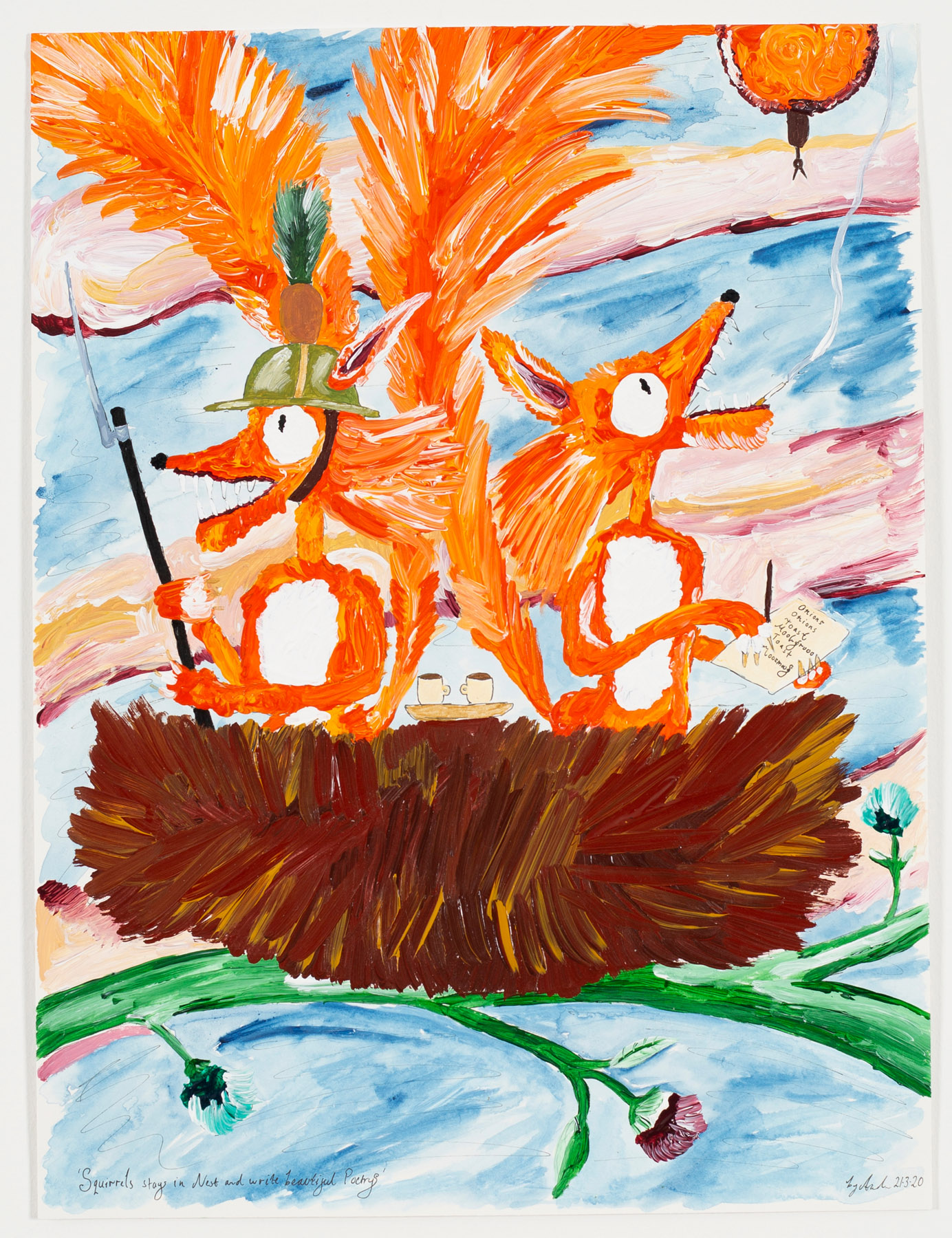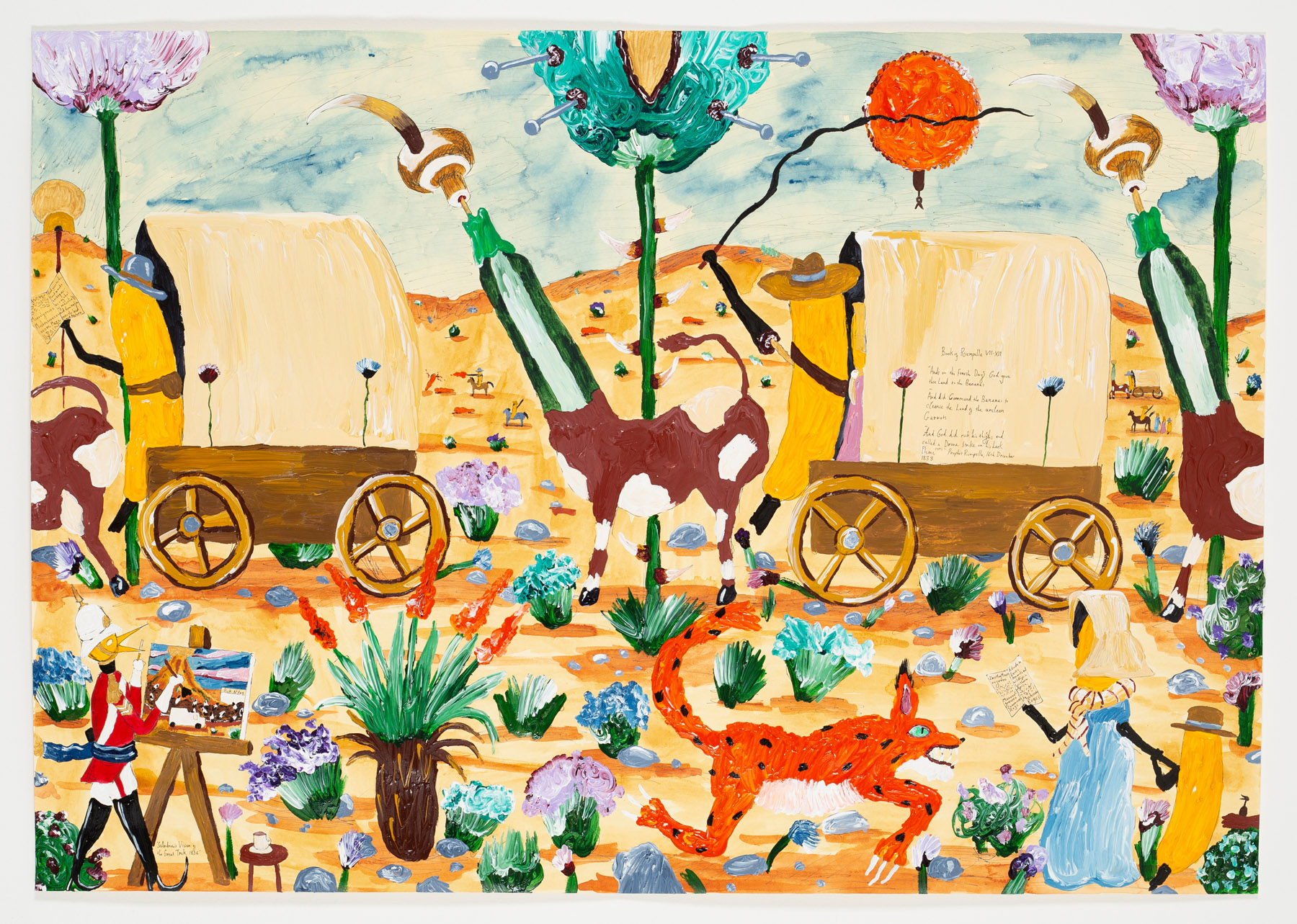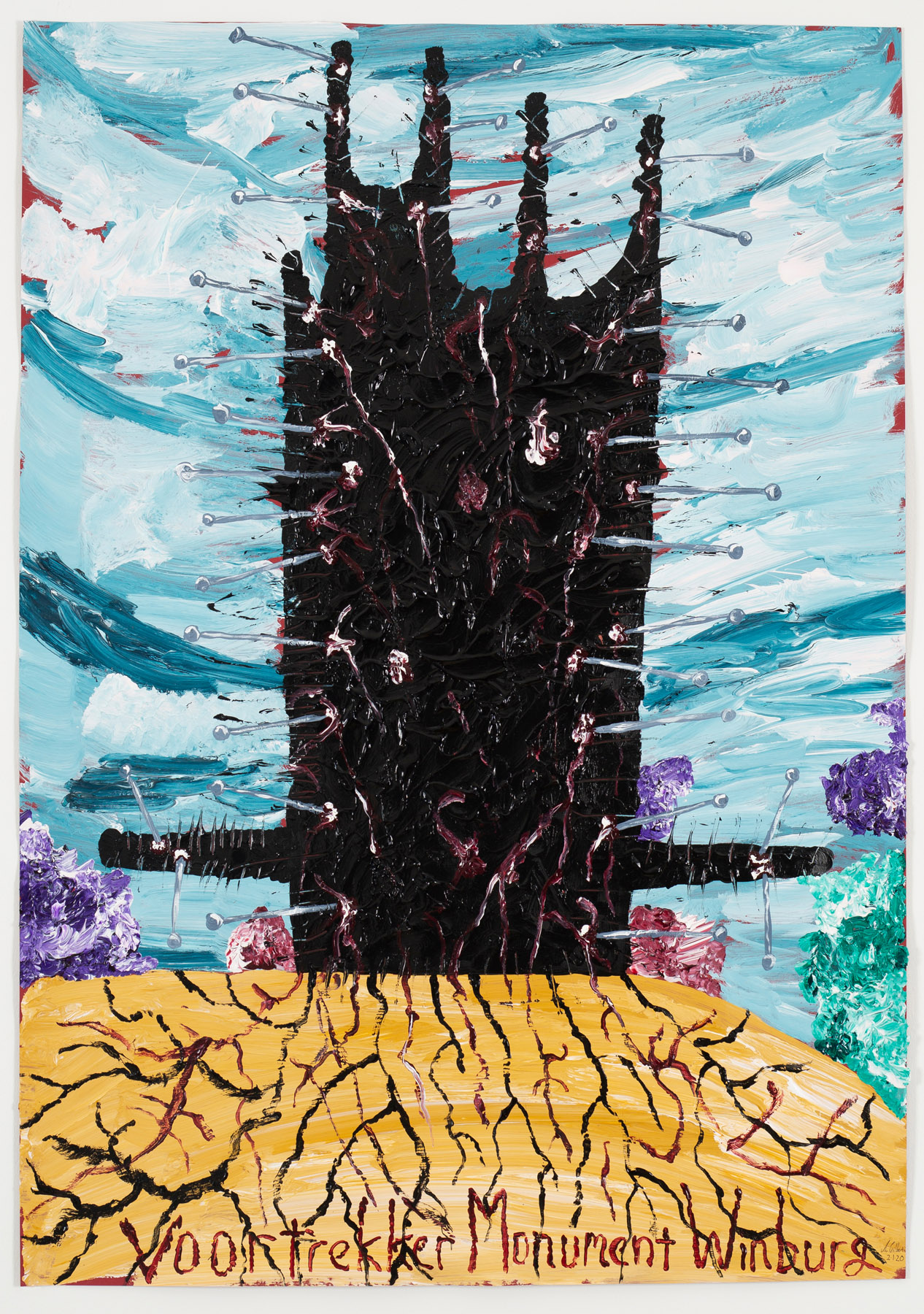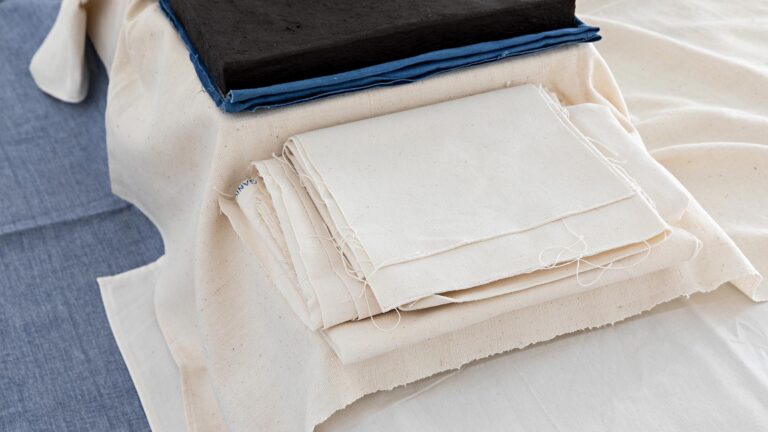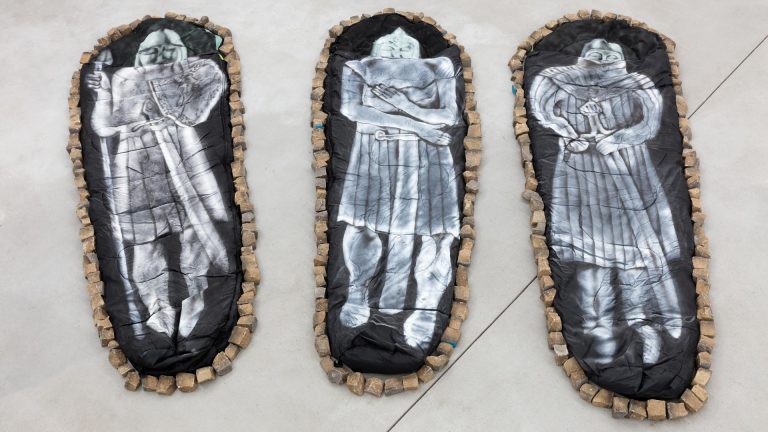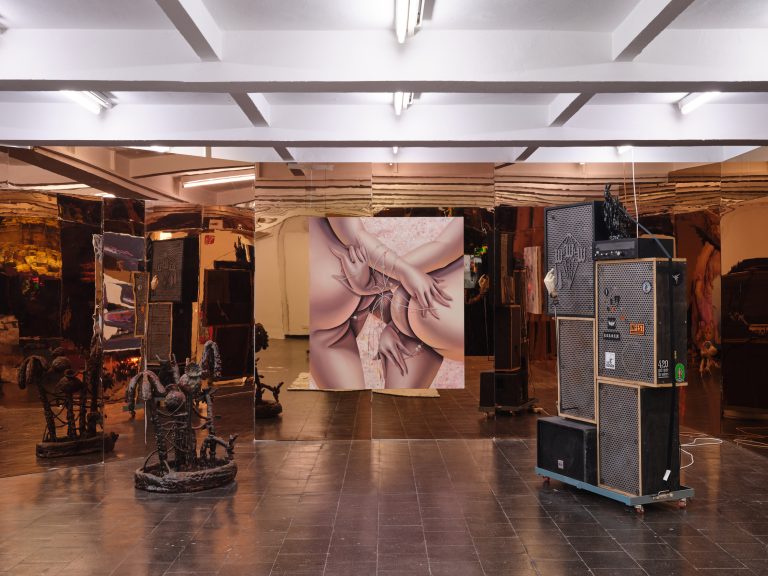Artist: Andrew Gilbert
Exhibition title: Saint Andrew’s Vision of the Great Trek – Settler Propaganda from 1836 to the Present Day – sponsored by Leek Phone (TM)
Venue: SPERLING, Munich, Germany
Date: October 23, 2020 – February 28, 2021
Photography: ©the artist. Courtesy of SPERLING, Munich. Photos by Sebastian Kissel
Who is Andrew Gilbert?
When Berlin based and Scottish born Andrew Gilbert visited South Africa in 2017 it was to continue his research on South Africa’s complex history. His South African imagery is part of a larger body of work where the issues of colonialism, exploitation, violence, materialism and corruption are highlighted. His artistic vision goes beyond the truths and lies which are the ofcial versions found in the academic texts and museum displays.In so doing he has assumed certain fantastical identities such as “Queen of Brocoli”, “Andrew the Emperor Liberator of the Dark Continent” and many others. These imaginary identities are part of his artistic oeuvre as his subjects are similarly de-personalised. These set the stage for that Suspension of Disbelief which can be described as the intentional avoidance of critical thinking or logic in examining something surreal.
What inspired him?
Andrew acknowledges that, as a young boy of 4 years old, he developed a lifelong fascination with Zulu history and in particular with that of Shaka kaSenzangakhona ( c. July 1787 ), also known as Shaka Zulu who was the King of the Zulu Kingdom from 1816 to 1828 when he was murdered by his brothers. The artist’s frst introduction was through the American TV mini- series “Shaka Zulu” in 1986. This production was highly criticised by the intelligentsia of the age. In a scathing review in the LA Times (September 21, 1986) Howard Rosenberg called it “gory, foolish and demeaning … yesteryear’s supposedly blood-lusting Zulus fll nearly every frame of “Shaka Zulu,” becoming a negative metaphor for today’s black South Africans, reinforcing a wild tribal image in contrast to the “civilized whites.” The prevailing belief was that the Apartheid South African government was behind “Shaka Zulu” and, understandably, couldn’t be trusted to provide a straight account of Zulu history.
“In fact, it may be the most violent TV production ever shown nationally in America. It has lots of blood spilling and blood drinking, lots of spearings and grisly impalings, with many of the impaled writhing on long sticks. There are burials of the living and a couple of beheadings, one of which afords close-ups of both the head and headless body.”
The strong images evoked by this movie must have played havoc on a young mind living in Scotland. These stayed with Andrew, who later developed as an artist portraying European and South African battles in his signature style, a mixture of absurdity and tragi-comedy. It is possibly these childhood memories which surfaced when he painted the image of the young, innocent,
wide eyed boys in their kilts who were involved in many of the colonial era wars where the British fought the Boers (Afrikaners) and adventure was the lure. But look closer at the image of those rosy cheeked boys and one sees body parts, horrifc blood and gore in a wide, angry landscape. The text inscribed over this painting, “Forward the Seaforth Highlanders” brings a chill to the viewer.
The South African images which we see in this exhibition are presented to us in in a manner where the action is brought to the forefront of the picture plane in an almost cinematic manner, resulting in a narrative in each frame. This artistic device may be compared to a stage setting bringing to mind many antecedents of the absurd; often in theatrical performances such as Ionesco’s Rhinoceros or Kafka’s Metamorphisis where Gregor Samsa becomes a “monstrous vermin”.
Why Vegetables?
As harsh and unrelenting as are the actions of most of Andrew’s protagonists presented to us, there is an underlying sense of their common traits. The majority of his subjects have been transformed from living, recognisable characters to featureless, non- human, non- animal anthropomorphic creatures. Does this soften the depiction of cruelty or does it give a universal edge where specifc individuals are not identifed? A challenge to the viewer. Ridiculous? Maybe – after all Andrew identifes himself as the “Queen of Brocoli”. We are consequently challenged at every level by these works.
In a discussion with me, Andrew recalled that “as a child I drew Grape and Pineapple people in battles. Then as a student, when I discovered ‘Tribal Art’ at the Museum in Edinburgh, I wanted to recreate the organic magical texture of mystics and anti -church views. Consequently, one carrot covered in nails (again alluding to object worship) came to represent the complete divine experience of Christ; the chopped carrot as the Host, a diluted Diet Cola version of religious experience that the worshiper receives through the structure of the Church.“ His constant use of vegetables brings to mind the inter relationship between agriculture and civilisation which is currently an important debate in our current ecological crises and It is important to remember that agriculture has been an important link to salvation and worship in ancient Zulu culture.
In a discussion with South African historian and museum curator, Steven Kotze, he reminded me of a Zulu ceremony frst practised in the 18th century in Shaka’s time. This was called Umkhosi (The First Fruit Ceremony of the National Harvest Festival) which was a fve-day festival where the Zulu King dressed in foliage, adorned himself with fruit and vegetables. This symbolic act of atonement is similar to the Jewish tradition of Yom Kippur.
The Leek Phone
Embedded in many of Andrew’s images is a critique of human capitalism and greed. When I questioned him about the meaning and origin of one of his most enduring symbols, the Leek phone, he replied: “My Leek Phoneä company was a successor to my Pineapple Juice Company called Cresswells, founded when I was an art student in Edinburgh in 1998. These pseudo-companies allow me to show the link, through humour and absurdity, between war and commerce, advertising and propaganda. They also comment on the contemporary worship of the object, the death of religion in the West.”
He continues with his idea that the Leek Phone is more globally contextual and compares the cell phone with ancient fetish objects which enabled the user to make contact with another reality.
The Leek Phone in this exhibition is inspired by the 11th century Romanesque Cathedral, Vezelay in France, known to be directly linked to the Crusader movement. Using elements from this cathedral’s architecture he embellishes the phone with an image of a suspended Judas which is accompanied by the parody slogan, “even when you are hanging around – Leek Phone connects.” The features of the two devils are depicted in the manner of African masks indicating a strong lineage of racism.
Museums and Monuments
When Andrew was a student in Edinburgh he was excited to fnd a Monument to the Highland Regiment in Edinburgh with the inscription “Andrew Gilbert, killed South Africa 1900”. Obviously a message for him from the Leek Phone. This stirred up his resolve to delve into the histories of the South African Wars – a passion which has marked a great deal of his artistic production. Last year in 2019 he fnally made the pilgrimage to visit the grave of his namesake (Major General Andrew Gilbert Wauchope) at the Magersfontein Battlefeld. His subsequent drawing depicts a Celtic Cross in the middle of a hot landscape while the entire graveyard is covered with small purple fowers , in contrast to the brown dry ground surrounding it. We know that, by their nature, monuments are erected by the victors but, as history tells us, the victors do not retain their glory forever. New battles, new losers, new winners are part of the march of history and monuments fall and crumble accordingly.
In his quest for the past in his 2019 research trip Andrew also visited the Voortrekker monuments in Winburg and Pretoria which are represented in the works on view. They were erected to commemorate white Afrikaans supremacy. His image of the Winburg memorial is that of chaos in a stormy wilderness whilst the Pretoria monument is shown with a red balloon making it drift into the air as though it no longer has a place. Other works show the simplicity and resolve of the early Voortrekkers who left the British controlled Cape Colony to escape British rule from 1835-1846. This was known as The Great Trek but the years developed into diferent wars and racial injustices such as the policy of apartheid and now a fawed democracy. None of this escapes the artist’s attention and it seems as though he steps back and allows the follies and greed of humankind to speak for themselves.It is a fact that new political dispensations create new heroes and attempt to discard earlier narratives. That is History.
Andrew’s work is an objective look at history where good and evil belong to both parties and he brings out the universal absurdity of power struggles, claims for land, prejudice and capitalistic worship of random objects. We come out of the exhibition with a realisation of the meaningless of all the battles and struggles which have been part of humanity’s “progress”. The vegetable characters bring to mind the fawed rationality and greed which can destroy and create chaos.
“In every tragedy, an element of comedy is preserved. Comedy is just tragedy reversed.” (Wislawa Szymborska)
By Carol Brown
Independent Curator/Writer and Former Director of Durban Museum and Art Gallery, Durban South Africa
Andrew Gilbert, Saint Andrew’s Vision of the Great Trek – Settler Propaganda from 1836 to the Present Day – sponsored by Leek Phone (TM), 2020, exhibition view, SPERLING, Munich
Andrew Gilbert, Saint Andrew’s Vision of the Great Trek – Settler Propaganda from 1836 to the Present Day – sponsored by Leek Phone (TM), 2020, exhibition view, SPERLING, Munich
Andrew Gilbert, Saint Andrew’s Vision of the Great Trek – Settler Propaganda from 1836 to the Present Day – sponsored by Leek Phone (TM), 2020, exhibition view, SPERLING, Munich
Andrew Gilbert, Saint Andrew’s Vision of the Great Trek – Settler Propaganda from 1836 to the Present Day – sponsored by Leek Phone (TM), 2020, exhibition view, SPERLING, Munich
Andrew Gilbert, Saint Andrew’s Vision of the Great Trek – Settler Propaganda from 1836 to the Present Day – sponsored by Leek Phone (TM), 2020, exhibition view, SPERLING, Munich
Andrew Gilbert, Saint Andrew’s Vision of the Great Trek – Settler Propaganda from 1836 to the Present Day – sponsored by Leek Phone (TM), 2020, exhibition view, SPERLING, Munich
Andrew Gilbert, Saint Andrew’s Vision of the Great Trek – Settler Propaganda from 1836 to the Present Day – sponsored by Leek Phone (TM), 2020, exhibition view, SPERLING, Munich
Andrew Gilbert, Saint Andrew’s Vision of the Great Trek – Settler Propaganda from 1836 to the Present Day – sponsored by Leek Phone (TM), 2020, exhibition view, SPERLING, Munich
Andrew Gilbert, Saint Andrew’s Vision of the Great Trek – Settler Propaganda from 1836 to the Present Day – sponsored by Leek Phone (TM), 2020, exhibition view, SPERLING, Munich
Andrew Gilbert, Saint Andrew’s Vision of the Great Trek – Settler Propaganda from 1836 to the Present Day – sponsored by Leek Phone (TM), 2020, exhibition view, SPERLING, Munich
Andrew Gilbert, Bojo tied to rock … and skinned alive, 2020, acrylic, fineliner and water colour on paper, 40 x 30 cm, Photo: Constanza Melendes, Courtesy SPERLING, Munich
Andrew Gilbert, New Concentration Camp Flavoured Chile Con Carne, South Africa, 1900, 2018, acrylic, fineliner and water colour on paper, 30 x 40 cm, Photo: Constanza Melendes, Courtesy SPERLING, Munich
Andrew Gilbert, “God gave us this Land” Voortekker Monument, Pretoria, 2020, acrylic, fineliner and water colour on paper, 40 x 30 cm, Photo: Constanza Melendes, Courtesy SPERLING, Munich
Andrew Gilbert, Battle of Ndondakusuka, Dec 2nd, 1856, 2nd Zulu Civil War, 2020, acrylic, fineliner and water colour on paper, 30 x 40 cm, Photo: Constanza Melendes, Courtesy SPERLING, Munich
Andrew Gilbert, Voortrekker Monument makes Picnic alone, 2020, acrylic, fineliner and water colour on paper, 40 x 30 cm, Photo: Constanza Melendes, Courtesy SPERLING, Munich
Andrew Gilbert, I’m Dying For a Pineapple Juice / Cresswells Pineapple Juice advert, 2020, acrylic, fineliner and water colour on paper, 40 x 30 cm, Photo: Constanza Melendes, Courtesy SPERLING, Munich
Andrew Gilbert, Leek Phone …Connecting People, 2020, acrylic, fineliner and water colour on paper, 40 x 30 cm, Photo: Constanza Melendes, Courtesy SPERLING, Munich
Andrew Gilbert, Squirrels stay in nest and write Beautiful Poetry, 2020, acrylic, fineliner and water colour on paper, 40 x 30 cm, Photo: Constanza Melendes, Courtesy SPERLING, Munich
Andrew Gilbert, Andrew your new Bronze, concept art sculptures are so politically correct, 2020, acrylic, fineliner and water colour on paper, 40 x 30 cm, Photo: Constanza Melendes, Courtesy SPERLING, Munich
Andrew Gilbert, Sacred Fetish Head of Lord Kitchener, 2020, acrylic, fineliner and water colour on paper, 64 x 50 cm, Photo: Constanza Melendes, Courtesy SPERLING, Munich
Andrew Gilbert, Forward! The Seaforth Highlanders, 2019, acrylic, fineliner and water colour on paper, 64 x 50 cm, Photo: Constanza Melendes, Courtesy SPERLING, Munich
Andrew Gilbert, The Great Trek, 1936, 2020, acrylic, fineliner and water colour on paper, 64 x 50 cm, Photo: Constanza Melendes, Courtesy SPERLING, Munich
Andrew Gilbert, “The White Man’s War”, 2020, acrylic, fineliner and water colour on paper, 64 x 50 cm, Photo: Constanza Melendes, Courtesy SPERLING, Munich
Andrew Gilbert, The Saint Parrot Rose of Ostkreuz, 2020, acrylic, fineliner and water colour on paper, 64 x 50 cm, Photo: Constanza Melendes, Courtesy SPERLING, Munich
Andrew Gilbert, Sketch of Andrew at the grave of Major General Andrew Gilbert, South Africa, December 23rd, 2019, 2020, acrylic, fineliner and water colour on paper, 50 x 64 cm, Photo: Constanza Melendes, Courtesy SPERLING, Munich
Andrew Gilbert, Battle of Blood River, Voortekker Monument, Pretoria, 2020, acrylic, fineliner and water colour on paper, 50 x 64 cm, Photo: Constanza Melendes, Courtesy SPERLING, Munich
Andrew Gilbert, St Andrew’s Vision of the Great Trek, 2020, acrylic, fineliner and water colour on paper, 70 x 100 cm, Photo: Constanza Melendes, Courtesy SPERLING, Munich
Andrew Gilbert, The Settlers witness the Sky transform into Frogs, 2020, acrylic, fineliner and water colour on paper, 100 x 70 cm, Photo: Constanza Melendes, Courtesy SPERLING, Munich
Andrew Gilbert, Voortrekker Monument Winburg, 2020, acrylic, fineliner and water colour on paper, 100 x 70 cm, Photo: Constanza Melendes, Courtesy SPERLING, Munich
Andrew Gilbert, Emperor Andrew on his Instant Coffee Plantation, 2019, acrylic, fineliner and water colour on paper, 100 x 70 cm, Photo: Constanza Melendes, Courtesy SPERLING, Munich
Andrew Gilbert, Kirchner Crucifixtion, 2020, acrylic, fineliner and water colour on paper, 40 x 30 cm, Photo: Constanza Melendes, Courtesy SPERLING, Munich














